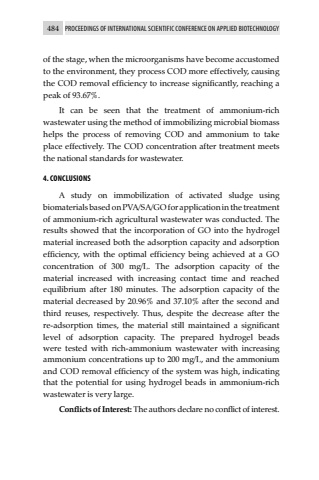Page 480 - Demo
P. 480
484 PROCEEDINGS OF INTERNATIONAL SCIENTIFIC CONFERENCE ON APPLIED BIOTECHNOLOGYof the stage, when the microorganisms have become accustomed to the environment, they process COD more effectively, causing the COD removal efficiency to increase significantly, reaching a peak of 93.67%.It can be seen that the treatment of ammonium-rich wastewater using the method of immobilizing microbial biomass helps the process of removing COD and ammonium to take place effectively. The COD concentration after treatment meets the national standards for wastewater.4. CONCLUSIONSA study on immobilization of activated sludge using biomaterials based on PVA/SA/GO for application in the treatment of ammonium-rich agricultural wastewater was conducted. The results showed that the incorporation of GO into the hydrogel material increased both the adsorption capacity and adsorption efficiency, with the optimal efficiency being achieved at a GO concentration of 300 mg/L. The adsorption capacity of the material increased with increasing contact time and reached equilibrium after 180 minutes. The adsorption capacity of the material decreased by 20.96% and 37.10% after the second and third reuses, respectively. Thus, despite the decrease after the re-adsorption times, the material still maintained a significant level of adsorption capacity. The prepared hydrogel beads were tested with rich-ammonium wastewater with increasing ammonium concentrations up to 200 mg/L, and the ammonium and COD removal efficiency of the system was high, indicating that the potential for using hydrogel beads in ammonium-rich wastewater is very large.Conflicts of Interest: The authors declare no conflict of interest.


